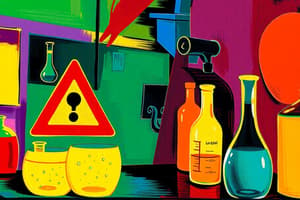Podcast
Questions and Answers
What is the primary responsibility of a laboratory director in managing risks?
What is the primary responsibility of a laboratory director in managing risks?
To perform risk assessment to manage and reduce risks to laboratory employees.
Why is assistance from a safety officer important in a laboratory?
Why is assistance from a safety officer important in a laboratory?
A safety officer helps identify potential risks and implement appropriate preventive measures.
What should safety procedures in a laboratory outline?
What should safety procedures in a laboratory outline?
They should describe actions to take in case of accidents, injuries, or contamination.
What are some examples of equipment that require specific safety training?
What are some examples of equipment that require specific safety training?
What measures should be taken when storing compressed gas cylinders?
What measures should be taken when storing compressed gas cylinders?
What is the recommended procedure if needle recapping is deemed necessary?
What is the recommended procedure if needle recapping is deemed necessary?
What are the risks associated with broken glass and sharps in a laboratory?
What are the risks associated with broken glass and sharps in a laboratory?
What findings were indicated by the study conducted by the Howard Hughes Medical Institute regarding laboratory risks?
What findings were indicated by the study conducted by the Howard Hughes Medical Institute regarding laboratory risks?
What specific labeling should be on a sharps container that holds non-biohazardous sharps?
What specific labeling should be on a sharps container that holds non-biohazardous sharps?
What is the maximum weight a cardboard box for laboratory glass disposal should have when full?
What is the maximum weight a cardboard box for laboratory glass disposal should have when full?
Identify the three main routes through which toxic chemicals can enter the body.
Identify the three main routes through which toxic chemicals can enter the body.
What should be included on labels for chemicals used in a laboratory?
What should be included on labels for chemicals used in a laboratory?
Explain why laboratory-acquired infections are a concern in medical laboratories.
Explain why laboratory-acquired infections are a concern in medical laboratories.
What precautions must containment level 2 laboratories have to ensure safety?
What precautions must containment level 2 laboratories have to ensure safety?
What is the purpose of a Material Safety Data Sheet (MSDS) in a laboratory setting?
What is the purpose of a Material Safety Data Sheet (MSDS) in a laboratory setting?
What are the consequences of improperly disposing of laboratory glass?
What are the consequences of improperly disposing of laboratory glass?
What specific storage measures should be taken for corrosive and toxic chemicals?
What specific storage measures should be taken for corrosive and toxic chemicals?
What actions should be taken for contaminated laboratory glass prior to disposal?
What actions should be taken for contaminated laboratory glass prior to disposal?
Flashcards are hidden until you start studying
Study Notes
Laboratory Safety
- Laboratory workers face various risks depending on their activities and analyses.
- Risk assessment is mandatory for laboratory directors to manage and reduce risks.
- Safety officers assist in identifying potential risks and implementing preventive measures.
- Emergency procedures should be outlined for accidents, injuries, and contamination.
- Records should be maintained for staff exposure to hazards, actions taken, and preventative measures.
Physical Risks in Laboratories
- A study by the Howard Hughes Medical Institute identified common physical risks.
- Personnel contamination and infection are also significant risks, even in high-containment facilities.
- Laboratory equipment is a primary source of potential injury.
- Training on safety procedures for equipment like autoclaves, centrifuges, compressed gas cylinders, and fume hoods is crucial.
- Electrical shock, microwave emissions, and radiation are also hazards.
Compressed Gas Safety
- Proper storage and handling of compressed gases are vital due to their unusual containers and high pressures.
- Cylinders must be chained to the wall to prevent falls.
- Safety caps should always be secured over the valve when moving or taking a gas cylinder out of service.
Sharps Disposal
- Needles, broken glass, and other sharps require careful handling and disposal to prevent infections.
- Needle recapping is discouraged but, if necessary, should be done with a one-handed technique.
- Sharps should be placed in puncture-resistant and leak-proof containers labeled "SHARPS."
- Non-biohazardous sharps should have their biohazard markings defaced before sealing the container.
Laboratory Glass and Plastic Ware Disposal
- Laboratory glass and plastic ware are not considered sharps but require different handling due to their potential to puncture regular waste bags.
- Sturdy cardboard boxes are needed for safe transport of laboratory glass.
- Boxes should be strong, no larger than 40 pounds when full, and not used for sharps, biohazardous materials, liquids, chemical contamination, or chemical containers.
- Contaminated laboratory glass must be decontaminated before disposal.
Chemical Safety
- Exposure to toxic chemicals poses a health and safety threat to laboratory staff.
- Inhalation, skin absorption, and ingestion are the main routes of entry for chemicals.
- Chemicals should be appropriately labeled with common names, concentrations, hazards, and additional information like date received, opened, and expiration.
- Proper storage is essential, separating corrosive, toxic, and reactive chemicals from ignitable substances.
- Radiochemicals require specific benches, covers, dedicated storage areas, and waste containers.
Material Safety Data Sheet (MSDS)
- MSDS is a technical document providing detailed hazard and precautionary information for chemicals.
- Businesses must distribute MSDS to customers for all chemicals they manufacture or distribute.
- Laboratories should follow MSDS guidelines to ensure safe handling and storage of chemicals.
- The MSDS provides information about the product, fire and explosion precautions, toxicology, health effects, personal protective equipment, storage recommendations, leak and spill procedures, waste disposal, and first aid.
Laboratory-Acquired Infections
- Laboratory-acquired infections are common in medical laboratories.
- Aerosols are the primary source of contamination, spreading over long distances.
- Containment systems focus on blocking aerosol diffusion in and outside laboratories.
- Ventilation is crucial for Level 2 laboratories, while higher containment laboratories require continuous inward airflow and absolute filtration of exhausted air.
Studying That Suits You
Use AI to generate personalized quizzes and flashcards to suit your learning preferences.




